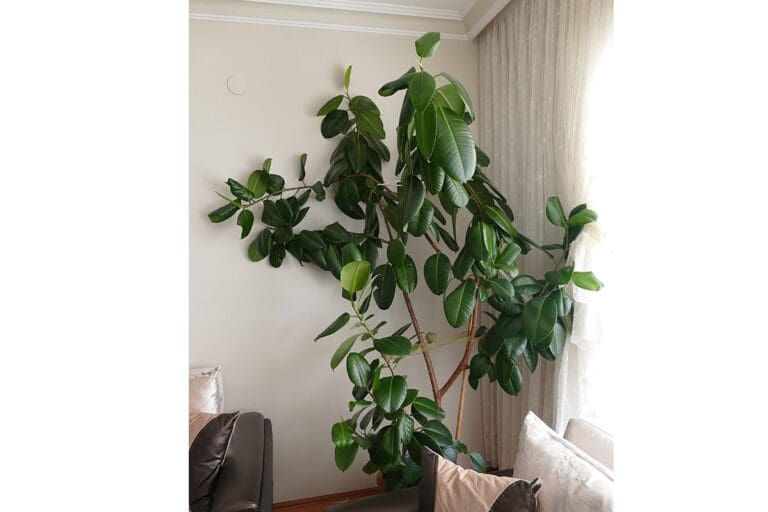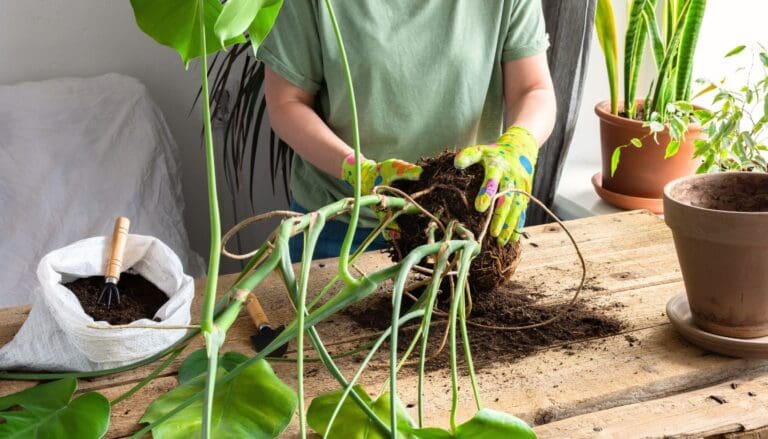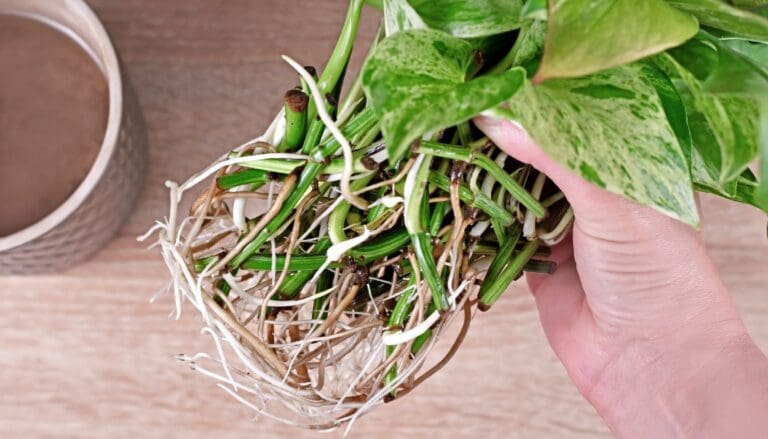How Fast Do Jade Plants Grow? (+Factors Affecting Growth)
Whenever we get a new plant home, we expect it to proliferate and brighten up space. However, not all plants grow at the same pace.
While some plants are fast growers like pothos, others are slow growers like a jade plant. So, you must be wondering what you should expect from a jade plant? How fast should a jade plant grow? Let’s find out!
On average, a jade plant will grow 2-4 inches every year till they reach a height of 6 feet. Being succulent, they need a temperature between 65°F-85°F and a humidity level below 50% to grow exponentially. If the temperature goes below 65°F, then the growth rate of the jade plant will slow down.
Jade plants are not very demanding, and if you can keep up with a few of their requirements, you will notice your plant bushier and happier than ever.
You must also check the species of jade plant you are growing and expect their growth and height accordingly.
In this article, we will understand the growth pace of a jade plant and the factors you need to keep in check to ensure healthy and quick growth.

Please note: Simplify Plants is reader-supported. Some links in the post are affiliate links and I get a commission from purchases made through links in the post.
Jade plant size
Jade plants can grow from 3 feet to 8 feet tall and 2 feet to 3 feet wide, depending on their growing conditions.
If the growing conditions are proper, you might see your jade plant grown up to 8 feet in a few years.
Different species grow differently in size. We have mentioned the names and height of the most common species of jade plants.
| Species | Height |
|---|---|
| Crassula ovata ‘lemon n lime’ | 3feet – 4 feet |
| Crassula ovata ‘skinny finger’ | 2 feet – 3 feet |
| Crassula ovata ‘Miniature jade plant’ | 2 feet – 3 feet |
| Crassula ovata ’Money plant’ | 1.1 feet – 3.5 feet |
| Crassula ovata ‘Pink jade plant’ | 4 feet – 5 feet |
9 Factors that affect the growth rate of the jade plant

If your jade plant is growing in the right amount, you need to consider the following essential factors for its optimum growth.
It will help you to keep your jade plant growing and developing at its best.
- Adaptability
- Type of potting soil
- Overfertilization of the jade plant
- Season for growth
- Watering regime
- Pruning
- Temperature and humidity
- Pests
- The size of the pot
Adaptability

Every living being needs time to adapt when moved to a new environment.
For example, if you travel from tropical region to mountain region, you will need time to adapt to the cold weather. You cannot do it immediately.
When you move a plant from one place to another, there is a difference in the environment. For example, moving plants indoors from outdoors, the plant will need time to adapt. As a result, it might get stressed out.
If you have bought a plant, it has gone through stages such as packaging, traveling, repotting. So they have been going through stress already.
You need to give them time to adjust to the new environment. Just let them be.
Sometimes planters fertilize newly bought plants or recently repotted plants. This may further stress them. If you wish, you can fertilize them in the following month when they have acclimated to the new surrounding.
Examine them and take time to understand your plant. Then, water them only when they need them. Watering excessively may stress them and can lead to stunted growth.
Type of potting soil

Potting medium plays an essential role in plant’s overall health and growth. If you do not use the right soil mix for your jade plant, you will find your jade plant wilting sooner or later.
Jade plants absorb nutrients and water from their soil. Therefore, it needs suitable soil to thrive. In addition, soil helps them to maintain their thick, fleshy, and glossy leaves.
Jade plants do not like water sitting in their soil. If the soil mix is heavy, the soil will get waterlogged easily, which will compromise the nutrients flow as well.
You will notice your plant facing the following issue due to the wrong type of soil mix:
- The soil will get waterlogged
- The soil will not allow air to flow easily
- The excess water will not be able to drain completely
- Root rot
The plant cannot grow properly in such conditions and may show signs of distress too. If ignored for a long time, the soil and roots will struggle to supply nutrients and oxygen to stems and leaves.
The leaves and stems further lose nutrients and water, resulting in loss of vigor. They show signs of stress by drooping, yellowing, falling off, etc.
We suggest the following mix for your jade plant:
- Two parts of well-draining potting mix
- 1 part compost
This mix will serve your plant as it is well-draining, nutrient-rich, and coarse, as liked by your jade plant. It will facilitate water, nutrients, and air movement in the soil and roots freely.
You can use soil mix formulated for succulents. They will also serve all the needs of your jade plant.
Also read: What kind of soil do jade plant need?
Overfertilization of the jade plant

Fertilizing is done to provide the plants with sufficient nutrients. But it should be monitored to prevent overfeeding. Over-fertilizing can harm your plant as it will lead to salt build-ups and other related issues.
Jade plants are light feeders and can go crazy when overfed. If you overfeed them, it can be in two ways, either you have given the wrong dosage, or you are feeding them too frequently.
Fertilizing jade plants once in the early spring and once at the end of the summer will do. It will help stimulate their growth in the growing season and keep them healthy in the dormant period.
Fertilize it with high nitrogen fertilizer, diluting it to half the strength. Diluting the fertilizer to half the strength is very important to avoid fertilizing.
Brown leaves, droopy leaves, and falling off are some of the signs of over-fertilized jade plants. If the situation is consistent, the plants can die, and you may lose your plant forever.
How might we right the over-fertilization?
Take your over-fertilized jade plant, position the soil in running water to flush out the excess salt in the soil. Repeat this 2-3 times to eliminate the excess fertilizer. Do this in the morning so that the plant dries out faster.
After the excess fertilizer has flushed out, avoid feeding them until the next month. If your plant doesn’t seem fine even after flushing the excess fertilizer, you need to take a more challenging step.
Repotting is the only way out; it will help renew the soil and help the plant grow better. Provide them with proper watering and enough light, and you will find them thriving again.
Season for growth
Jade plants are slow growers, and they grow in the spring throughout the summer. Feeding them right, watering appropriately, and providing enough light will nourish them and give you a growing jade plant.
Jade plants can grow 2″ tall in the year if they are given proper care. But, of course, it depends on the type of jade plant you own.
Taking extra care of your jade plant in the growing season is like putting the cherry on the cake.
In the dormant period, it is hard for jade plants to grow. You will hardly see any growth in them during this season. It is their resting period as the light is weak, and they function slowly in this time.
Please do not feed them during this time and avoid watering them more than once a month. Otherwise, you will end up stressing them.
You do not need to worry if your jade plant is not growing in the dormant period. They need to take a rest at this time and will grow in the growing season.
Watering regime

You can turn down Jade plants just by watering wrong, which is mostly overwatering. They can be stressed easily by overwatering for longer periods.
They suffer a lot when continuously watered excessively. You might be following a watering regime blindly. You may soak the soil and roots in water, suffocating the plant altogether.
The best way to water your jade plant right is by touching the soil to check if it is dry or moist. If the soil feels dry, only then you should water them.
How can we get the watering right?
By following the steps below, you can get the watering right:
- Choose a light soil mix for your jade plant.
- Feel the soil before watering.
- The soil should be completely dry to touch.
- If the soil feels moist, then wait for a few days.
- Check the soil from within by digging deeper to feel the soil.
- According to this, you can make a watering regime.
- You keep an alarm or stick a note to the plant to manage your task.
- Make sure you always check the soil before watering, even if you are following a routine.
- Check the drainage system of the pot.
- If using a saucer, throw away the excess water collected in it.
Jade plants store water in their leaves and stems. They do not like too much water. They can stay without water for long periods though.
During winters, they hardly ask for water. Watering them once a month and a half is enough. This also depends on the environment they are growing in.
Keeping a check on the soil every few days will help you overcome over-watering and prevent underwatering.
Also read: How often should I water my jade plant?
Pruning

Jade plants grow taller with time and feel like they are healthy and happy. However, they grow taller and heavier on the top, due to which a single trunk cannot support it. As a result, the growth and the health of the plant suffer.
Pruning is recommended for the jade plant before it gets to this point to distribute the weight of the plant evenly. In addition, it will give your plant the right shape and better growth.
If your jade plant is not growing, the reason could be that the plant is top-heavy, and the roots, soil, and trunk cannot support it. As a result, there are chances that the plant may fall upside down if not pruned at the right time.
Pruning on time will benefit your jade plant in many ways. However, you must also know when to prune them.
Things to consider for pruning
Consider the following points before pruning your jade plant.
- The best time to prune the jade plant is during the growing season, especially spring.
- Pruning during winters can shock them and affect their growth.
- Starting pruning jade plants when they are very small is advised.
- Disinfect the tools you are using while pruning.
- Disinfecting helps to remove the diseases and pests, if any.
- Clip off any damaged and dead parts of the plant and dispose of them.
- Prune when the jade plant is overgrown.
- You can repot healthy pruned parts of the plant.
- Do not prune more than 30% of the plant.
Temperature and humidity

Jade plants can survive in multiple conditions by keeping their ideal needs aside, and they will thrive. Though they may show signs of distress if continuously exposed to unfavorable conditions.
If they are kept in direct bright light for longer periods, the leaf starts to burn. If kept in low light for longer periods, the leaves turn yellow, and the plant may not grow bushy.
They do not like cold weather a lot; they may suffer when exposed to cold drafts or kept near windy windows.
Therefore, keeping them away from heating systems such as vents, radiators, furnaces, etc., is equally essential.
They love room to high temperature and low to average humidity and will grow their best in such conditions.
Jade plants grow faster in a temperature atmosphere ranging between 65°F-85°F. Therefore, move them indoors during winters and keep them in a space with a warm temperature and moderate humidity.
Pests

Jade plants are resilient plants and known to keep pests at bay, but some pests can still have a chance on them. They are mealy bugs, scales, spider mites, and aphids.
Jade plants are mostly affected due to overwatering. It decays root and makes the plant vulnerable, and creates the perfect environment for pests to attack and thrive.
However, it could be possible that these pests are coming from other contaminated plants too.
Yellowing leaves, drooping leaves, brown and black spots on leaves are few signs of pests attack. However, you need to immediately check your plant closely to understand the seriousness of the situation.
Quarantine your pest-infested jade plant immediately to save other plants in the surroundings and also check other plants for signs of pests.
There are two options to fix pests infestation:
1. Organic way
2. Chemical pesticides
If you take the first option, then neem oil should be your first preference. Adulterate 2 tbsp neem oil to a gallon of water and spray all over the plant.
Repeat it till the pests and their eggs have been completely killed.
You can also go for pesticides readily available in the market. But, again, make sure you read the instructions correctly before buying them. They must be for your plant.
Do not add pesticides or other products to your plant while using pesticides, as it can further harm your plant and not just pests.
It will take time for the plant to recover to a sound situation, be patient, and do not make the mistake of over-fertilizing or over-watering them, adding to the stress.
The size of the pot

The size of the pot is ignored by many planters while planting their jade plant. Yet, it is a crucial factor in plants’ overall growth and development.
If the size of the pot is small for your jade plant, the roots get little space to grow and become root-bound.
Thus, it hinders their growth. In addition, if the pot is oversized, the soil will be soaked in water and will not support its growth.
It is suggested to shift the plant to the right pot size. For example, you can allow the roots to develop in a pot they have come in. Once developed, move it to a bigger pot.
The best way to understand which pot is perfect for your jade plant is by following this rule.
If the plant’s diameter is about 4″, then use a 5″ pot for them. The pot size should be slightly larger than the diameter of your plant.
If your plant roots have developed wholly or outgrown the existing pot, it’s time to report in a bigger pot.
Also read: What happens when you put a plant in too big of a pot?
Final words
Jade plants are easy to care for and maintain. All you need is the proper knowledge for keeping them growing.
By following the above points, you can quickly notice your jade plant back to good health and growing at its optimum speed.
They should not be stressed with anything and examining them every few days will help you understand their needs.
Also read: How To Make House Plants Grow Faster? (Crucial Factors+9 Secret Tips)
Source: NYBG, The University of Arkansas, University of Florida, Phytochemical and Antimicrobial Activity of Jade Plant, CABI, University of Minnesota, The University of Missouri.
Recommended Garden Supplies
| Product Image | Our Recommended Gardening Supplies | Check Offers! |
|---|---|---|
Top Top
Top
Top
Top
Top
Top
Top
Top | rePotme Houseplant and Tropical Classic Potting Soil Mix | Check Offer On Amazon |
 Top
Top
Top
Top
Top
Top
Top
Top | Espoma Organic Indoor Plant Food | Check Offer On Amazon |
 Top
Top
Top
Top
Top
Top
Top
Top | GooingTop LED Grow Light 6000K Full Spectrum Clip Plant Growing Lamp | Check Offer On Amazon |
 Top
Top
Top
Top
Top
Top
Top
Top | Soil Moisture Meter | Check Offer On Amazon |
 Top
Top
Top
Top
Top
Top
Top
Top | Govee Hygrometer Thermometer, Bluetooth Enabled! | Check Offer On Amazon |
 Top
Top | LEVOIT Humidifiers for Large Room(Best For Plants) | Check Offer On Amazon |
 Top
Top
Top
Top
Top
Top
Top
Top | Upgraded DIY Automatic Drip Irrigation Kit, 15 Potted Houseplants Support | Check Offer On Amazon |
 Top
Top
Top
Top
Top
Top
Top
Top | Stainless Steel Heavy Duty Gardening Tool Set | Check Offer On Amazon |
 Top
Top
Top
Top
Top
Top
Top
Top | Bonide Insecticidal Soap | Check Offer On Amazon |
 Top
Top
Top
Top
Top
Top
Top
Top | Bonide 32 oz Spray Neem Oil for Organic Gardening | Check Offer On Amazon |
 Top
Top
Top
Top
Top
Top
Top
Top | Garden Safe Fungicide | Check Offer On Amazon |






